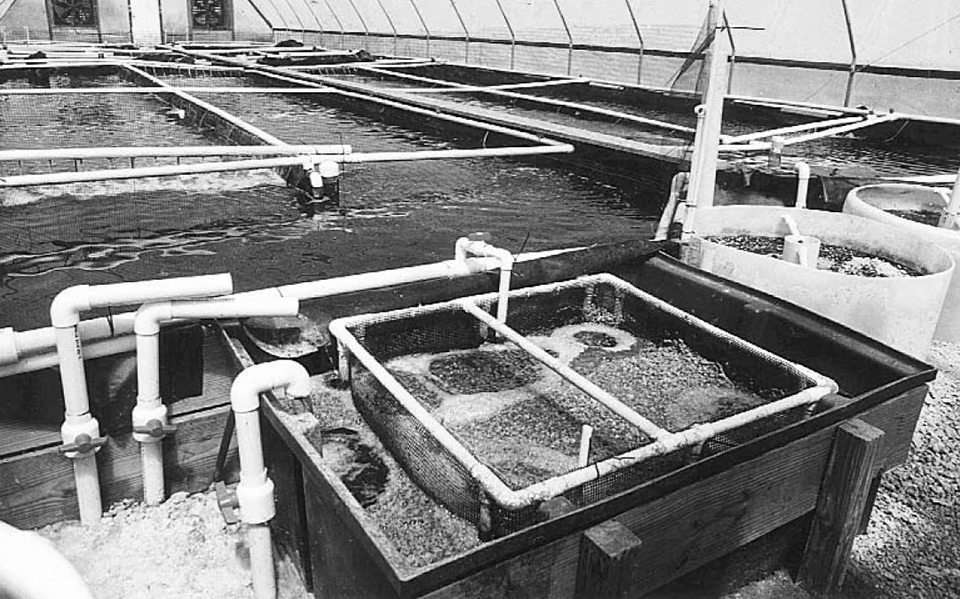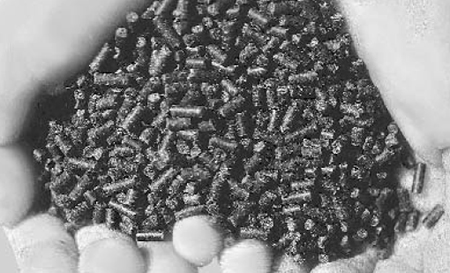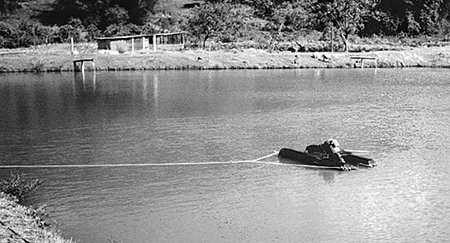Nutrition and filtration aspects

Pond culture is a system in which many environmental subsidies are realized, including sunlight, wind, water and soil, while no such subsidies are available in a recirculating aquaculture system (RAS). In an RAS, all inputs and outputs are more easil quantified, but they also have quantified costs. Even an efficient RAS will appear to have higher operating costs than a traditional pond, but there will also be fewer negative environmental costs.
Feed is the major source of potential pollutants (e.g., NH3/NH4) in recirculating aquaculture systems. Hence, the physical and nutritional qualities of the feed, as well as the methods to present it, have as much to do with culture water and effluent quality as do the animals’ digestive and metabolic abilities.
System inputs and outputs
The quality (palatability, physical characteristics, and nutrient composition) and quantity (feeding rate and frequency) of the feed input affect the wasted feed and excretion, as well as the growth of the cultured animals.
Filtration systems

These same factors also affect the design of components and size of filtration systems, due to their effects on suspended particulates and nitrogen wastes. Feeding frequency and rate, as well as animal biomass and feed protein content, also have an effect on the total ammonia nitrogen (TAN) added to the system. TAN value then determines the size and cost of the filtration components, bead filter, and fluidized sand filter.
For example, using a feed with improved amino acid balance would add to feed costs, but could result in lower protein levels, better assimilation with enhanced growth, and reduced TAN loads to the system. As a result of these factors, a less-expensive filtration system would be required. Hence, the inputs and outputs are inextricably tied together, and one must approach the optimization of an RAS from both the input and output ends.
Cost-effective feed program
The Hazard Analysis and Critical Point (HAACP) concept can be applied directly to the development of aquaculture feeds of any type, but especially high-performance feeds for intensive RAS. The most critical step is to identify the rate-limiting factors that affect the development of a costeffective feed.
In general, the following five areas are of greatest concern for RAS feeds:
- Understanding the reduction or loss of natural productivity in an RAS versus a pond.
- Application of low-pollution or “environmentally friendly” feeds to RAS.
- Feed management as a tool to improve feed utilization and reduce nutrient loading in RAS.
- Use of feeding attractants, incitants, and stimulants to improve feed utilization in RAS.
- Development of feed additives for improving disease resistance and immune response in RAS.
Reduction or loss of natural productivity

Whatever the species, feed used in an RAS must satisfy all the minimum nutrient requirements for the cultured animals, because there will be little or no natural productivity in the tanks. A lack of vitamin C in feed used for laboratory rearing of shrimp resulted in over 50 percent mortality within three weeks. In contrast, up to 6 metric tons (MT) per hectare per crop with over 80 percent survival and 2 grams per week growth have been produced for shrimp reared in earthen ponds on a feed with no supplemental vitamin C. Moreover, it has been shown that the contribution to nutritional requirements varies for different classes of nutrients. Differences in the nutritional value of natural productivity have been demonstrated to be speciesrelated as well.
Some recent research seems to contradict the need for complete feeds, and suggests that protocols will be developed to create natural productivity in an RAS. While most of the research has been done in small recirculating ponds, there is some indication that large raceway systems could be created in which natural productivity – bacterial as well as algal – can provide significant nutrients to the cultured animals.
In general, these systems have not been operated for long periods in continuous production modes, and the longterm effects on settling particulates and elevated nitrate and phosphorous concentrations have not been evaluated. However, it is clear that bacterial and algal populations can be manipulated in ways that would benefit the operation of an RAS.
Environmentally friendly feeds
The most enigmatic aspect of aquatic nutrition is the fine point at which nutrients become pollutants in terms of inputs as well as outputs. In fact, it is hard for a nutritionist to ever consider carbon, nitrogen and phosphorous as pollutants unless they interfere with normal metabolism. However, engineers and environmental scientists consider these elements to be exactly that when they are suspended or dissolved in effluent.
System designers must create containment or filtration systems to remove or convert these pollutants to lessidentifiable forms, regardless of their impact on the system itself. There are three major classes of nutrients/pollutants from feeds: nitrogenous compounds, dissolved and particulate organic matter, and phosphate.
Nitrogenous excretory products
The production of nitrogenous pollutants reflects the complexity of factors that impact pollution. For aquatic animals, ammonia is the major excretory product. It generally comprises 70 to 80 percent of all nitrogenous catabolites excreted, and is quantified as TAN. The three major groups of factors that affect the amount of ammonia excretion are non-dietary, dietary, and feed management strategies.
Non-dietary factors
Non-dietary factors can be subdivided into two groups: biological or biotic, and abiotic factors. Biotic factors are animal age, size, species (e.g., herbivorous or carnivorous), and others. Abiotic factors are pH, temperature, salinity, ambient ammonia concentrations and others.
Dietary factors
Examples of dietary factors that affect ammonia excretion include factors that affect digestive enzyme activity (e.g., activators and inhibitors), nutrient availability or apparent digestibility, protein-sparing action through optimized feed energy level, and protein quality of essential dietary amino acid profile.
Using a feed low in one of the essential amino acids will result in the under-utilization of the remaining amino acids until the animal satisfies the deficiency. As a result, the excess amino acids will be metabolized for energy, adding TAN to the system with little benefit to growth. And one must realize this additional TAN has capital and operating costs of filtration.
Protein content
Recent laboratory research has shown the protein content of pelleted feeds can be decreased significantly, by optimizing the preceding dietary factors and feed management strategies. This reduction has major environmental ramifications, or in the case of RAS, significant effects on filtration system design. One can estimate the contribution of nitrogen from feeds containing 15 percent protein and 30 percent protein, since FCR, production values, and amount of feed added to pond systems are known.
Results have shown that a 15 percent protein feed contributed 60 percent less dissolved nitrogen than a 30 percent protein feed. Hence, development of environmentally friendly feeds can make a significant impact on the accumulation rate of pollutants in RAS, and consequently on the size, efficiency and operation of filtration systems. In the future, RAS feeds may be formulated in terms of environmental impact rather than least cost, although low-pollution or environmentally friendly feeds may be more expensive than least-cost formulated feeds.
(Editor’s Note: This article was originally published in the February 2001 print edition of the Global Aquaculture Advocate.)
Now that you've finished reading the article ...
… we hope you’ll consider supporting our mission to document the evolution of the global aquaculture industry and share our vast network of contributors’ expansive knowledge every week.
By becoming a Global Seafood Alliance member, you’re ensuring that all of the pre-competitive work we do through member benefits, resources and events can continue. Individual membership costs just $50 a year. GSA individual and corporate members receive complimentary access to a series of GOAL virtual events beginning in April. Join now.
Not a GSA member? Join us.
Authors
-
Phillip G. Lee, Ph.D.
Director, National Resource Center for Cephalopods,
University of Texas Medical Branch
Galveston, Texas, USA -
Addison L. Lawrence, Ph.D.
Reagent Professor and Project Leader
Texas A&M Shrimp Mariculture Project
Port Aransas, Texas, USA
Tagged With
Related Posts

Innovation & Investment
A review of unit processes in RAS systems
Since un-ionized ammonia-nitrogen and nitrite-nitrogen are toxic to most finfish, controlling their concentrations in culture tanks is a primary objective in the design of recirculating aquaculture systems.

Innovation & Investment
AquaBounty, with new RAS facility, hopes to win public support for GM salmon
Ron Stotish, CEO of AquaBounty Technologies, believes genetically modified salmon is no threat to its opponents and the outlook for AquAdvantage is good. With its purchase of the Bell Fish Co. RAS facility, commercialization will soon commence.

Innovation & Investment
Competitiveness comes at scale for RAS operations
Total RAS salmon production worldwide is less than half of 1 percent of total production. Many of the investors flocking to the sector now are new to fish farming, and confident in its potential.

Health & Welfare
Biofilter inoculation in recirculating aquaculture systems
Biological filters are essential parts of recirculating aquaculture systems that transform toxic fish compounds such as ammonium and nitrite into less-harmful nitrate. The authors tested the convenience and efficiency of three methods for the initial inoculation of aerobic biofilters.


